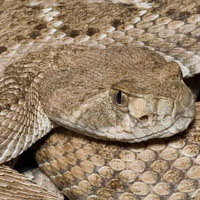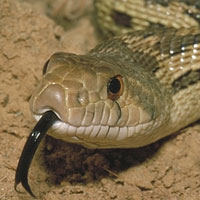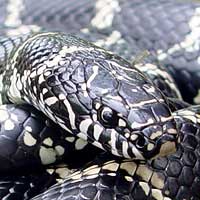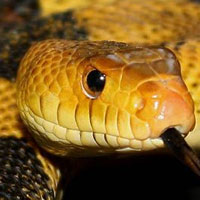Discover the Fascinating World of the Western Diamondback Rattlesnake
The Western Diamondback Rattlesnake (Crotalus atrox) belongs to the Viperidae snake family, specifically the subfamily Crotalinae, which includes pit vipers equipped with heat-sensing pits and venomous fangs.
Scientific Name: Crotalus atrox
Snake Family: Viperidae

An Overview of the Western Diamondback Rattlesnake
The Western Diamondback Rattlesnake (Crotalus atrox) is one of the most iconic and widely recognized venomous snakes in North America. Found across arid and semi-arid regions, this species is known for its diamond-shaped dorsal patterns and distinctive rattle at the tip of its tail. The rattle serves as a warning to potential threats, helping to prevent unwanted encounters. With potent venom that is both hemotoxic and proteolytic, this rattlesnake plays a crucial ecological role by controlling rodent populations. Despite its fearsome reputation, the Western Diamondback Rattlesnake is not inherently aggressive and will often retreat when given the opportunity.
Where Does the Western Diamondback Rattlesnake Live?
The Western Diamondback Rattlesnake thrives in a variety of environments, showcasing its adaptability. Key habitat characteristics include:
- Geographic Range: Found in the southwestern United States and northern Mexico, including Texas, Arizona, New Mexico, and California.
- Preferred Environments: Deserts, grasslands, scrublands, rocky outcrops, and woodlands.
- Climate: Adapted to arid and semi-arid climates with high temperatures and low rainfall.
This snake is commonly found near water sources such as rivers and streams, particularly during the warmer months when hydration is essential. It often shelters in burrows, under rocks, or within crevices to escape the heat or predators. Below is a table summarizing its habitat preferences:
| Habitat Feature | Description |
|---|---|
| Geographic Range | Southwestern United States and northern Mexico |
| Preferred Terrain | Deserts, grasslands, scrublands |
| Climate | Arid and semi-arid |
What Does the Western Diamondback Rattlesnake Eat?
The Western Diamondback Rattlesnake is a carnivorous predator, playing a key role in its ecosystem. Key dietary details include:
- Primary Prey: Rodents, such as mice and rats, which are abundant in its habitat.
- Occasional Prey: Birds, lizards, and amphibians, depending on availability.
- Hunting Strategy: Ambush predator that uses its heat-sensing pits to detect prey, followed by a venomous strike to immobilize and digest its food.
The Western Diamondback’s diet helps control pest populations, making it a vital part of agricultural ecosystems. Its ability to adapt to various prey availability ensures its survival in diverse habitats.
Understanding the Behavior of the Western Diamondback Rattlesnake
The Western Diamondback Rattlesnake exhibits fascinating behaviors that reflect its survival instincts. Key traits include:
- Activity Patterns: Primarily crepuscular or nocturnal, particularly during warmer months, but may bask in the sun during cooler weather.
- Defensive Behavior: Vibrates its rattle as a warning, assumes a coiled posture, and may strike when threatened.
- Social Behavior: Solitary, except during mating season or when sharing hibernation dens.
While its defensive behaviors may appear aggressive, they are primarily warning signals to avoid confrontation. Understanding these behaviors can help prevent negative encounters.
Health and Lifespan of the Western Diamondback Rattlesnake
The Western Diamondback Rattlesnake is a resilient species with a relatively long lifespan. Important health details include:
- Lifespan: 15-20 years in captivity, with slightly shorter lifespans in the wild due to predation and environmental factors.
- Health Threats: Habitat destruction, road mortality, and persecution by humans.
- Predators: Birds of prey, coyotes, and other snakes pose threats, particularly to juveniles.
Conservation efforts aimed at preserving natural habitats and educating the public about the ecological role of this species are essential for its survival.
How Does the Western Diamondback Rattlesnake Reproduce?
The reproductive habits of the Western Diamondback Rattlesnake ensure its continued presence in its ecosystem. Key details include:
- Mating Season: Occurs in the spring and early summer.
- Reproductive Method: Ovoviviparous, meaning females give birth to live young.
- Litter Size: Produces 10-20 offspring per litter, depending on the female’s size and health.
- Hatchling Behavior: Newborns are independent and venomous, capable of hunting small prey immediately.
Protecting breeding grounds is critical to ensuring the species’ long-term survival.
Safety Guidelines for Handling the Western Diamondback Rattlesnake
Handling the Western Diamondback Rattlesnake requires expertise and extreme caution. Key safety tips include:
- Use specialized tools such as snake hooks and secure transport containers.
- Wear protective gear, including gloves and boots, to minimize bite risks.
- Ensure enclosures mimic the snake’s natural habitat and are escape-proof.
- Have antivenom readily available and a detailed emergency response plan.
Interactions with this venomous snake should be left to professionals. Educating the public about its behavior and ecological role is essential for coexistence.
Disclaimer
The information provided in this article is for educational purposes only. SnakeEstate strongly advises against handling or interacting with venomous snakes, such as the Western Diamondback Rattlesnake, unless you are a trained and licensed professional. These snakes pose significant risks, and improper handling can result in serious injury or death. Always adhere to local regulations and prioritize safety when dealing with wildlife.
Other Snakes In This Species
 Asp Viper
Asp Viper Black Mamba
Black Mamba Boomslang
Boomslang Brazilian Coral Snake
Brazilian Coral Snake Bushmaster
Bushmaster Coastal Taipan
Coastal Taipan Common Death Adder
Common Death Adder Common European Adder
Common European Adder Copperhead
Copperhead Coral Snake
Coral Snake Cottonmouth
Cottonmouth Eastern Brown Snake
Eastern Brown Snake Eastern Diamondback Rattlesnake
Eastern Diamondback Rattlesnake Egyptian Cobra
Egyptian Cobra Fer-de-lance
Fer-de-lance Forest Cobra
Forest Cobra Indian Cobra
Indian Cobra Inland Taipan
Inland Taipan Jameson’s Mamba
Jameson’s Mamba King Cobra
King Cobra Lancehead
Lancehead Lataste’s Viper
Lataste’s Viper Malayan Krait
Malayan Krait Mojave Rattlesnake
Mojave Rattlesnake New Guinea Small-eyed Snake
New Guinea Small-eyed Snake Nose-horned Viper
Nose-horned Viper Puff Adder
Puff Adder Russell’s Viper
Russell’s Viper Saw-scaled Viper
Saw-scaled Viper Solomon Island Coral Snake
Solomon Island Coral Snake South American Rattlesnake
South American Rattlesnake Tiger Snake
Tiger Snake Western Diamondback Rattlesnake
Western Diamondback Rattlesnake









